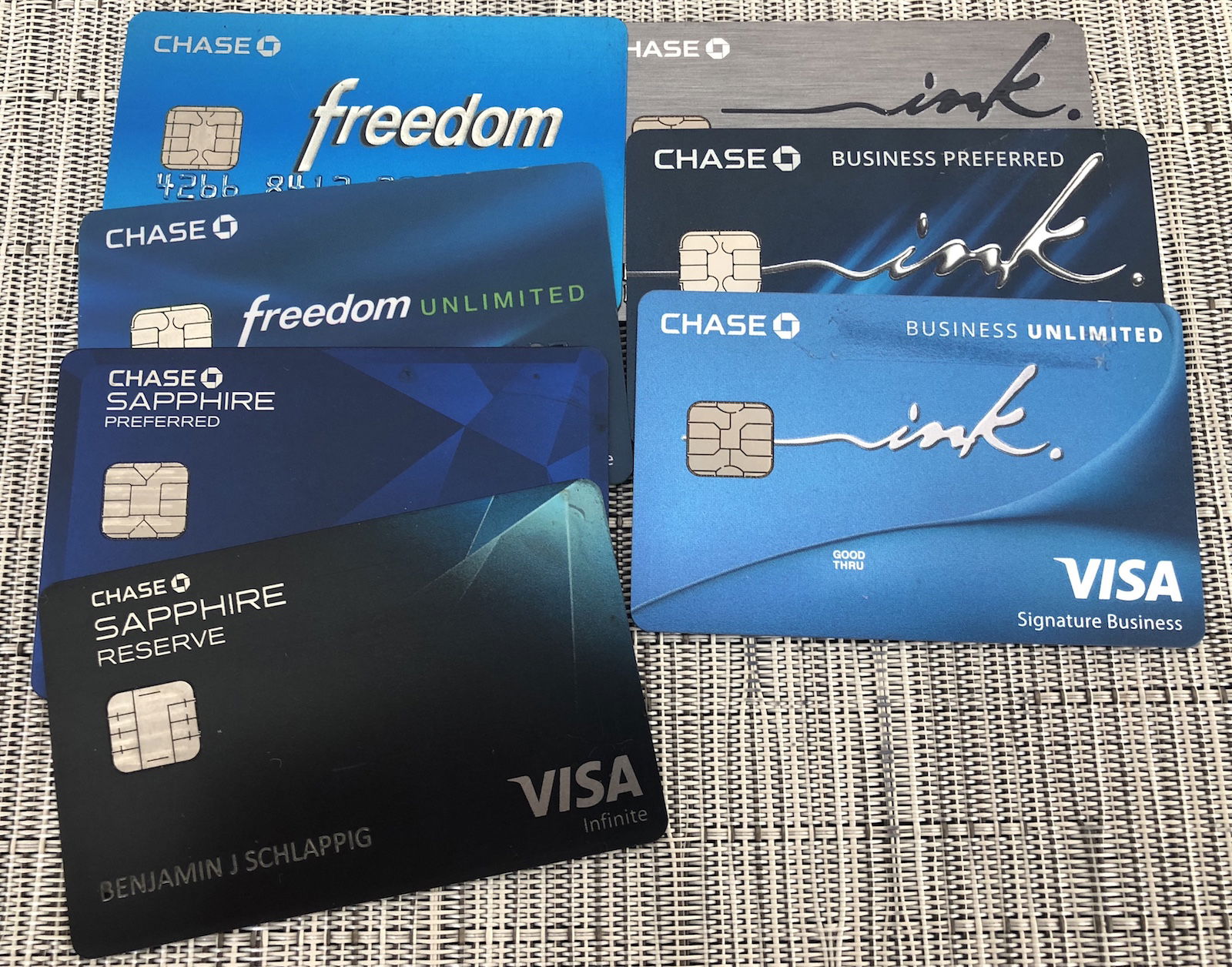There are lots of aspects to maximizing your credit card rewards, including taking advantage of the best welcome bonuses, spending categories, and card perks.
Sometimes I think it’s interesting to break down credit card strategies by card issuer, so in this post I wanted to share my current Chase card strategy. Chase has some of the best points earning credit cards out there, though Chase cards can also be among the toughest to be approved for.
Here’s a rundown of what you need to know to be approved for a Chase card, a summary of my strategy, and then which Chase cards I’m most interested in applying for. In separate posts I wrote about my Amex card strategy, Capital One card strategy, and Citi card strategy.
How many Chase cards can you have?
There’s no set limit to how many Chase cards you can have. For example, I have nine Chase cards, though I know people who have more than that. With Chase, the limiting factor is typically the total amount of credit the bank is willing to extend you. This means that if you apply for a new card and are maxed out in terms of the credit Chase is willing to issue you, you may be asked to transfer credit lines around.
The other big restrictions involve the application process, as I’ll explain below.
Restrictions on applying for Chase cards?
There are a few major restrictions to be aware of when applying for Chase cards…
The Chase 5/24 rule
Chase has what’s known as the “5/24 rule,” whereby you sometimes won’t be approved for a new Chase card if you’ve opened five or more new card accounts in the past 24 months. For this reason it often makes sense to apply for as many Chase cards as possible early in your credit card journey, since these are cards you may not be able to pick up in the future.
Note that as a general rule of thumb, business credit cards won’t count toward that limit, whether issued by Chase or another card issuer. When you are applying for Chase cards, you’ll want to prioritize business applications ahead of personal applications.
However, note that nowadays, the 5/24 rule no longer seems to be consistently enforced. There are lots of data points of people being approved for Chase cards in spite of being over the limit, though it’s anyone’s guess how that’s decided. If you’re not sure if you’re subjected to the rule or not, it can always be worth applying, as the downside to a rejection is limited.
Waiting between Chase applications
You typically won’t be approved for more than two Chase cards in a 30 day period. Some report only being able to get approved for one Chase card in that period. Personally to be on the safe side I wouldn’t apply for more than one personal and one business card in a 30 day period.
Chase 24/48 month rule
The exact terms will vary by card, so you’ll always want to carefully check the terms of your credit card application. Usually Chase will only approve you for a card if you don’t currently have it, and if you haven’t received a new cardmember bonus on the card in the past 24 months.
However, for some cards (like the Sapphire Preferred and Sapphire Reserve) that waiting period is even longer, up to 48 months.
“Family” card rules
For some cards, Chase has a “family card” rule. Essentially Chase won’t approve you for a card if you currently have a card in the family, or have received a new cardmember bonus on a card in the family in the past 24-48 months.
This is the case with the Chase Sapphire Reserve® and Chase Sapphire Preferred® Card, for example. If you have one of those cards, then you can’t be approved for the other card, and vice versa.
Similar restrictions apply to some Marriott cards and Southwest cards, though you won’t find this with Hyatt cards.
Which Chase cards do I have?
At the moment I have the following nine Chase cards (as you can see, there’s a heavy focus on cards earning Ultimate Rewards points), and that’s also the most cards I have with any issuer. Here are the Chase credit cards that I have:
How do I use my Chase cards?
There are different reasons that I have Chase credit cards:
- Some I have for the ongoing perks that they offer
- Some I have for the return on spending that they offer
- Some I have for a combination of the two factors
Below I’ll break down the reasons I have each of the Chase cards in my wallet.
Chase cards I have for the perks
I have both the IHG One Rewards Premier Credit Card and IHG Rewards Club Select Credit Card specifically for the anniversary free night certificates that the cards offer, each valid at a property costing up to 40,000 points per night (and you can even use points to top off these certificates and redeem at more expensive hotels).
That alone more than justifies the annual fees on both cards, and is also a reason to pick up an IHG Card.
That’s not even factoring in the other perks of the IHG Premier, including IHG One Rewards Club Platinum status, a fourth night free on award redemptions, and more.
Chase cards I have for the perks & spending bonuses
The World of Hyatt Credit Card pays for itself with the perks alone. It has a $95 annual fee, and I keep it because it offers an annual free night certificate valid at a Category 1-4 property, plus five elite nights toward status annually. That more than justifies the annual fee, in my opinion.
But I also end up putting $15,000 of spending on the card per year, as spending that amount gets me:
- A second Category 1-4 free night certificate
- An additional six elite nights toward status annually (two for every $5,000 spent)
Even though I have lifetime Globalist status, I still value earning elite nights, for the incremental benefits offered through the Milestone Rewards program.

Chase cards I have for the spending bonuses
I have the other six Chase credit cards for the return on spending that they offer, though I’m not actively using all of them. These cards make up what I like to call the “Chase holy grail.”
More specifically:
- The Chase Sapphire Reserve® Card has a $550 annual fee and offers 3x points on dining and travel, plus all kinds of perks, including a $300 annual travel credit, a Priority Pass membership, Chase Sapphire Lounge access, great travel and purchase protection, and much more
- The Chase Freedom FlexSM has no annual fee and offers 5x points in rotating quarterly categories, on up to $1,500 of spending per quarter, plus 3x points at drugstores and on dining
- The Chase Freedom Unlimited® has no annual fee and offers 1.5x points on all purchases, making this one of the best personal cards for everyday spending; the card also offers 3x points at drugstores and on dining
- The Ink Business Preferred® Credit Card has a $95 annual fee and is one of the all-around best business credit cards, offering 3x points on the first $150,000 of combined purchases per cardmember year on travel, shipping, internet, cable, phone services, and advertising purchases made with social media sites and search engines
- The Ink Business Cash® Credit Card has no annual fee and offers 5x points on the first $25,000 of combined purchases per cardmember year on office supply stores, internet, cable TV, mobile phones, and landlines, and 2x points on the first $25,000 of combined purchases per cardmember year on restaurants and gas stations
- The Ink Business Unlimited® Credit Card has no annual fee and offers 1.5x points on all purchases
I don’t think there’s a more ideal combination of cards to be had with any issuer, as Chase cards get everything from much of my bonused spending, to much of my everyday, non-bonused spending.

Which Chase cards do I most want?
At this point I’m happy with my portfolio of Chase credit cards, and I have most of the cards I really want. However, Chase has so many good cards, and there are of course some that would be nice to have, potentially.
For example, the following three cards are on my radar:
On top of that, there are three cards earning Avios (which you can transfer between programs), all of which are quite compelling, and have generous welcome bonuses:

Bottom line
I’d say Chase has the all-around most compelling portfolio of rewards cards at the moment. Between the excellent co-branded cards and the cards earning Ultimate Rewards points, there are so many great opportunities to maximize points.
The main thing to keep in mind is that Chase cards are also among the toughest to get approved for, so consider the timing of applying for Chase cards.
I’m really happy with my nine current Chase credit cards. Some cards I find valuable for the perks they offer just for being a cardmember, while other cards I find valuable for the return on spending they offer. There are a few more Chase cards I’d love to pick up, but even without them, I’m still very happy with my setup.
What does your Chase card strategy look like nowadays?












Leave a Reply